Looking for current poverty data? Visit the following
- USA Counties in Profile (complete with state/national data)
- Poverty and Welfare Topic Page
Poverty in the United States
Indiana has the third-lowest poverty rate in the nation, according to the U.S. Census Bureau (see Figure 1). On average, 8.3% of Indiana residents lived in poverty between 1997 and 1999. Nationally, poverty afflicts 12.6% of the population, or 34.4 million people. Imagine—34.4 million equals the entire population of Indiana times six, and they all live in poverty. Yet current poverty rates are the lowest since the late 1970s, even when broken down by age or race and ethnicity.
Click on map below to see larger version with data.
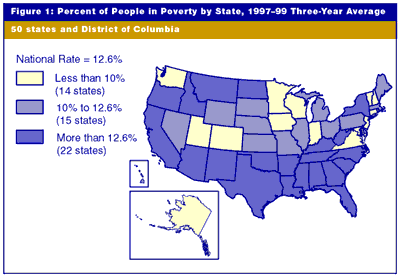
Unfortunately, lower poverty rates do not necessarily mean that fewer people are in poverty relative to the past. The rate is only a percentage of the total population, which has grown since the 1970s. For example, in 1980, 12.6% of the population would have equaled 28.5 million people compared to today's 34.4 million because the U.S. population has grown by 46.2 million since 1980. So while the proportion of the population in poverty may be the same, 5.9 million more people—approximately the population of Indiana—live in poverty today than in 1980 had the rate then been 12.6%.
Looking closer to home, Indiana has the fewest number of people in poverty compared to its surrounding states (see Figure 2).
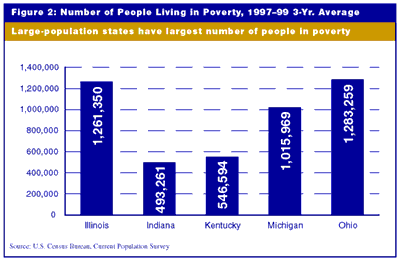
With a poverty rate of 8.3%, there are 490,000 Hoosiers living in poverty (see Table 1 and Figure 3). Kentucky has the largest percentage of impoverished residents (13.8%), while Ohio has the highest number of individuals living in poverty (1.2 million).
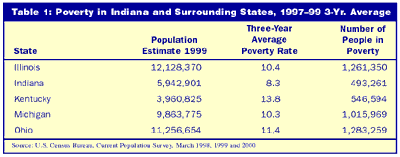
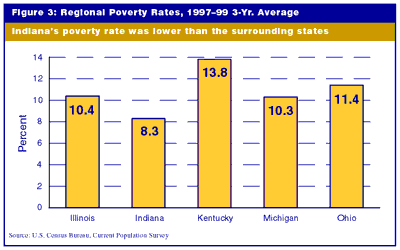
Poverty levels by state are often used to distribute federal funding for programs such as the Children's Health Insurance Program (CHIP), Head Start and the National School Lunch Program. Workforce-development funding and Community Development Block Grant allocations are also influenced by state poverty rates. These programs are far more effective at redistributing our nation's wealth than changes to our tax structure, according to the Census Bureau's June report on income distribution.
Defining poverty
Individuals and families are considered impoverished if their pre-tax income falls below the U.S. Census Bureau's poverty thresholds. The thresholds are based on two variables resulting from past research done by the U.S. Department of Agriculture:
- the cost of the "economy food plan," which provided a nutritionally adequate diet for the least amount of money, and
- evidence that a family of three or more persons spends approximately one-third of their income on food.
Thus, to survive, a family of three would need an income of at least three times the cost of the economy food plan. The result is then adjusted by household size and the number of children in the household. In 1963, when this poverty measure was developed, the threshold for a family of four was $3,128. Today, that same family would need an income of more than $17,029 to be considered above the poverty line (see Table 2).
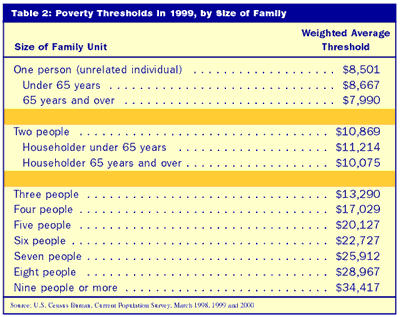
It is generally accepted that this methodology underestimates the level of poverty in the United States. At the same time, it does not show the impact of taxes and public assistance on family income or regional differences in the cost of living. Although improvements of this measure are regularly under consideration, there is no hope that a new measure will make poverty vanish.
